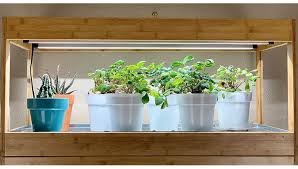The Complete Guide to Growing Vegetables Indoors Without Sunlight
Growing fresh vegetables indoors without natural sunlight may sound challenging, but with modern technology and proper techniques, it’s entirely possible to cultivate a productive indoor garden year-round. Whether you live in an apartment with limited windows or simply want fresh produce during winter months, this comprehensive guide will walk you through every step of successful indoor vegetable gardening without relying on sunlight.
Why Grow Vegetables Indoors Without Sunlight?
Indoor vegetable gardening offers numerous advantages:
- Year-round harvests regardless of outdoor weather conditions
- Complete control over growing environment
- No pesticide exposure from commercial farming
- Space efficiency for urban dwellers
- Reduced water usage compared to outdoor gardens
Essential Equipment for Sunlight-Free Indoor Gardening
1. Artificial Grow Lights
The foundation of sunlight-free gardening is a quality lighting system. Consider these options:
LED Grow Lights
- Most energy-efficient option
- Full-spectrum models mimic sunlight
- Low heat output prevents plant damage
- Long lifespan (50,000+ hours)
Fluorescent Grow Lights
- Affordable entry-level option
- T5 or T8 tubes work best
- Good for leafy greens and herbs
High-Intensity Discharge (HID) Lights
- Powerful option for fruiting plants
- Requires more energy and cooling
- Best for experienced growers
2. Growing Containers
Choose containers based on your space and plant types:
- Fabric pots (excellent aeration)
- Plastic pots (lightweight and affordable)
- Self-watering containers (reduce maintenance)
- Hydroponic systems (most efficient for some crops)
3. Growing Medium
Soil alternatives work particularly well indoors:
- Coco coir (excellent water retention)
- Peat-based mixes (sterile and lightweight)
- Hydroponic substrates (clay pebbles, rockwool)
- Vermiculite/perlite mixes (good for seed starting)
4. Environmental Controls
Maintain optimal conditions with:
- Thermometer/hygrometer to monitor temperature and humidity
- Small fans for air circulation
- Humidifier for dry indoor air
- Timer for automated light cycles
Best Vegetables to Grow Indoors Without Sunlight
These varieties perform particularly well in artificial light conditions:
Leafy Greens (Easiest to Grow)
- Lettuce (harvest in 30-45 days)
- Spinach (continuous harvest)
- Kale (cold-tolerant)
- Swiss chard (colorful and nutritious)
Herbs (Great for Beginners)
- Basil (pinch regularly to encourage bushiness)
- Parsley (slow but steady grower)
- Cilantro (quick harvest)
- Mint (vigorous – grow separately)
Fruiting Vegetables (More Challenging)
- Cherry tomatoes (dwarf varieties work best)
- Peppers (compact varieties preferred)
- Dwarf cucumbers (require trellising)
Root Vegetables (Possible with Deep Containers)
- Radishes (quickest harvest)
- Baby carrots (need deep pots)
- Microgreens (harvest in 1-3 weeks)
Step-by-Step Growing Process
1. Setup Your Growing Area
- Designate a space with access to power for lights
- Reflective walls (mylar or white paint) maximize light efficiency
- Ensure proper ventilation to prevent mold
2. Planting Your Vegetables
- Start with quality seeds or seedlings
- Follow proper planting depth for each variety
- Use clean containers with drainage holes
3. Lighting Schedule
- 16-18 hours daily for leafy greens and herbs
- 12-14 hours daily for fruiting plants
- Use timers to maintain consistency
4. Watering Techniques
- Check soil moisture daily
- Water when top inch feels dry
- Avoid overwatering – root rot is common indoors
5. Nutrient Management
- Use balanced liquid fertilizer every 2-3 weeks
- Reduce nitrogen for fruiting plants
- Flush soil monthly to prevent salt buildup
6. Pollination (For Fruiting Plants)
- Gently shake plants when flowering
- Use small paintbrush to transfer pollen
- Consider self-pollinating varieties
Advanced Techniques for Better Yields
1. Hydroponic Systems
- Deep Water Culture (DWC): Plants suspended in nutrient solution
- Nutrient Film Technique (NFT): Continuous flow of nutrients
- Ebb and Flow: Periodic flooding of grow trays
2. Succession Planting
- Stagger plantings every 2-3 weeks
- Ensures continuous harvest
- Maximizes space efficiency
3. Pruning and Training
- Pinch back herbs for bushiness
- Use trellises for vining plants
- Remove lower leaves to improve air circulation
Common Challenges and Solutions
1. Leggy Plants
- Cause: Insufficient light intensity
- Solution: Lower lights or increase wattage
2. Yellowing Leaves
- Cause: Overwatering or nutrient deficiency
- Solution: Adjust watering schedule, check pH
3. Slow Growth
- Cause: Low temperatures or poor nutrition
- Solution: Maintain 65-75°F, fertilize appropriately
4. Pests
- Common: Fungus gnats, spider mites
- Solution: Neem oil, sticky traps, proper ventilation
Cost Analysis: Is Indoor Gardening Worth It?
While initial setup costs can be $200-$500, long-term savings include:
- Reduced grocery bills for fresh herbs and greens
- No transportation costs for store-bought produce
- Potential to grow expensive specialty varieties
Many growers find the hobby pays for itself within 1-2 years while providing superior quality produce.
Final Thoughts
Growing vegetables indoors without sunlight is an achievable and rewarding endeavor. By selecting the right plants, investing in proper lighting, and maintaining consistent care, you can enjoy fresh, homegrown produce regardless of outdoor conditions or living space limitations.
Start small with a few leafy greens or herbs, learn as you grow, and gradually expand your indoor garden. The satisfaction of harvesting your own pesticide-free vegetables year-round makes the effort worthwhile.
For those ready to begin, we recommend starting with a simple lettuce crop under LED lights – you could be harvesting your first salad in just 4-6 weeks. The world of indoor gardening awaits!
